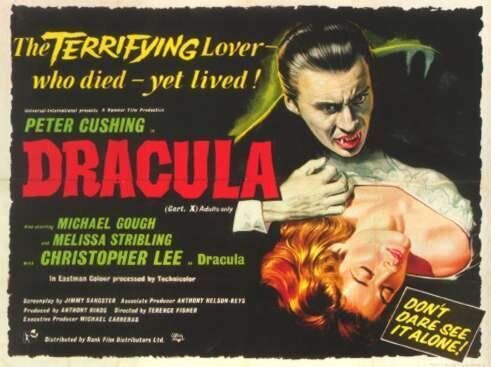
The best thing about Halloween is undoubtedly the fact that it gives us carte blanche to spend the day, evening, weekend or whole week (depending on your partner's enthusiasm for Halloween, of course), watching nothing but horror movies.
I've always been a huge fan of horror movies and I've made a few of my own - Devil's Playground, Elfie Hopkins and the forthcoming World War Dead: Rise of the Fallen.
So I decided to spend my Halloween picking my all-time top 5 Horror movies. In no particular order, here they are. Reckon I've got it right?
DRACULA (1958)
Windsor-based family business Hammer Films reinvented the horror movie as sexy, violent and in crimson technicolour with The Curse of Frankenstein in 1957.
Initially conceived as a black and white vehicle for ageing genre icon Boris Karloff, it brought eventual stars Peter Cushing and Christopher Lee overnight celebrity and paved the way for this: the definitive screen adaptation of Bram Stoker's classic novel.
Lee, who barely has any dialogue, made the vampire count an icy sexual predator, with bosomy maidens welcoming his nightly advances rather than screaming in fear.
Cushing, meanwhile, made for a sprightly and very British hero - light years away from Stoker's glum Dutchman, tearing about the Transylvanian countryside and going toe to toe with the Count for a blistering climax.
Writer Jimmy Sangster pares down the novel effectively (gone is fly-eating madman Renfield, one vampire bride becomes three and the stormy ship journey to England is jettisoned in a model of cost-cutting efficiency) while director Terrence Fisher humanizes the characters and makes the danger feel real.
Its hard to believe that this movie is over fifty years old as it has lost none of its power or spectacle. No matter how many times Hollywood tries to reinvent Dracula as a tragic new romantic with long hair, Lee's commanding, unstoppable vampire remains the definitive one.
WITCHFINDER GENERAL (1968)
One of the companies most influenced by Hammer's genre success was Tigon, which made a number of fun monster films with silly titles in the late sixties including The Blood Beast Terror (Peter Cushing tracks a giant blood-sucking Deaths' Head Moth through the Norfolk countryside) and The Curse of the Crimson Altar (Christopher Lee's reincarnated witch does battle with Boris Karloff's wheelchair-bound occult expert over some sinister antiques).
Witchfinder General is a very different prospect, however, and remains an incredibly compelling piece of cinema. Director Michael Reeves, making his third and final film (he would die from a suspected accidental overdose the following year) pulls out all of the stops to deliver what is essentially a gothic Western, with Vincent Price putting in the performance of his career as the sleazy Witchfinder Matthew Hopkins.
Ian Ogilvy holds his own with him throughout as a soldier whose intended is in Hopkins's crosshairs for a good ducking and the climax is as nihilistic as anything in American films of the period.
Long available only in a heavily cut version, this is worth seeing in all its gory glory, though the torture scenes are nowhere near as powerful as the human drama.
THE WICKER MAN (1973)
Perhaps the perfect definition of Cult Movie, The Wicker Man is almost as famous for its convoluted release as it is for being one of the best films to come out of Britain in the seventies.
Edward Woodward is terrific as the principled, repressed mainland copper investigating the disappearance of a schoolgirl on the pagan island of Summerisle, meeting resistance from Christopher Lee's disarmingly suave laird and Britt Ekland's saucy barmaid.
The script, by Sleuth writer Anthony Schaffer, is something very special indeed and the weird, folky vibe that pervades the movie is years ahead of the curve and creates a palpable sense of unease.
Despite this offbeat brilliance, or perhaps because of it, distributor British Lion didn't know what to do with the film, and all but buried a cut down version of it as a support feature to the excellent Don't Look Now.
Burying became a theme as rumours of cut footage being used as roadfill under motorways soon began to circulate and Lee, rightly miffed at the prospect of his best work being used in such a demeaning way, led a campaign for its restoration.
It remains unlikely we'll ever see the whole thing but the version available on DVD and Blu Ray is just the right balance of teasing enigma and spooky satisfaction. Best not to dwell on the banal remake starring Nicolas Cage.
FROM BEYOND THE GRAVE (1973)
In 1964 another would-be Hammer rival, Amicus, produced cult portmanteau outing Dr Terror's House of Horrors, setting a template for its genre movies which would last a decade and include Torture Garden (featuring Burgess Meredith as the devil), The House That Dripped Blood, Tales From The Crypt and The Vault of Horror.
Usually either penned by Psycho scribe Robert Bloch, or adapted from the pages of the 1950s EC horror comics, these films have a tendency to blur into one repetitive cycle of 20 minute vignettes with recalcitrant guest stars hamming it up for an easy pay cheque.
From Beyond The Grave, the last in this cycle of anthology films, has by far the strongest sense of identity and is a cut above its multi-story stablemates.
Peter Cushing (who else?) owns a spooky antiques shop that deals in death as well as curios: in an unusually dishonest neighbourhood, three out of his four customers try to swindle him and pay the ultimate price.
The first buys Jack The Ripper's mirror and is drawn into the underworld by the killer's spirit. In the second story, Ian Bannen is a Walter Mitty type who buys a distinguished service medal to try and impress beggar Donald Pleasence. Pleasence and his real life daughter Angela make a truly chilling family of demons in this episode, which also includes a cameo from Diana Dors as Bannen's overbearing wife.
There's an episode with a haunted snuff box which contains a sex-mad Elemental and a particularly impressive segment in which Ian Ogilvy buys a blue door which is a gateway to another time.
Saintly Ogilvy turns out to be honest, however, and manages to seal the door before a satanic cavalier can escape into an unsuspecting 1973.
The stellar cast also includes Lesley Ann Down, David Warner and Jack Watson and Cushing presides over it all, puffing gently on a pipe and dispensing puns in an unsettling Yorkshire burr.
As the door closes on his sinister shop at the end of the movie its like a door closing on the golden age of British horror films as a slew of Exorcists, Chainsaw Massacres and Nightmares on Elm Street prepared to take the genre in a very different direction.
AN AMERICAN WEREWOLF IN LONDON (1981)
Despite being a key part of mainland Europe's folklore, the werewolf has been portrayed as a peculiarly British monster on the big screen, going back to early black and white efforts Werewolf of London and The Wolfman.
Despite this, Hammer's lone attempt - The Curse of the Werewolf starring Oliver Reed - was set in Spain but came and went with more of a whimper than a howl.
It took an American director - John Landis - to make the first truly great werewolf movie and humour rather than wolfsbane to bring out the best in the beast.
Two American students fail to heed the warnings of the oddball patrons of the Slaughtered Lamb pub and stray off the path in the Yorkshire moors. Attacked by the local werewolf, one is murdered but the survivor, David (David Naughton), awakes in hospital in London with amnesia.
Plagued by terrifying dreams of murder and monsters he is taken in by a particularly minxy nurse (Jenny Agutter) but as the full moon blooms something very wolfy begins to stir within him.
The perfect mixture of horror and humour, this remains the best werewolf movie ever made. The scary bits - the nazi nightmare, the monster rampaging through Picadilly Circus and the truly iconic scene where the werewolf stalks a lone commuter through a late night tube station like a lycanthropic Jaws - are about as scary as it gets.
Even the cover of the video, with its ape-like mid transformation monster, scared a generation of kids in the 80s. But the lighter moments, underscored by a truly inspired soundtrack, give this movie a multi-layered feel. This is real gallows humour and you can see how much Landis' work is influenced by the classic horrors he loved as a boy.
If you watch one movie this Halloween make it this one: just be grateful the moon isn't full.
Jonathan's latest film, revenge thriller We Still Kill The Old Way - starring sometime British horror film hero Ian Ogilvy - is released in December.
